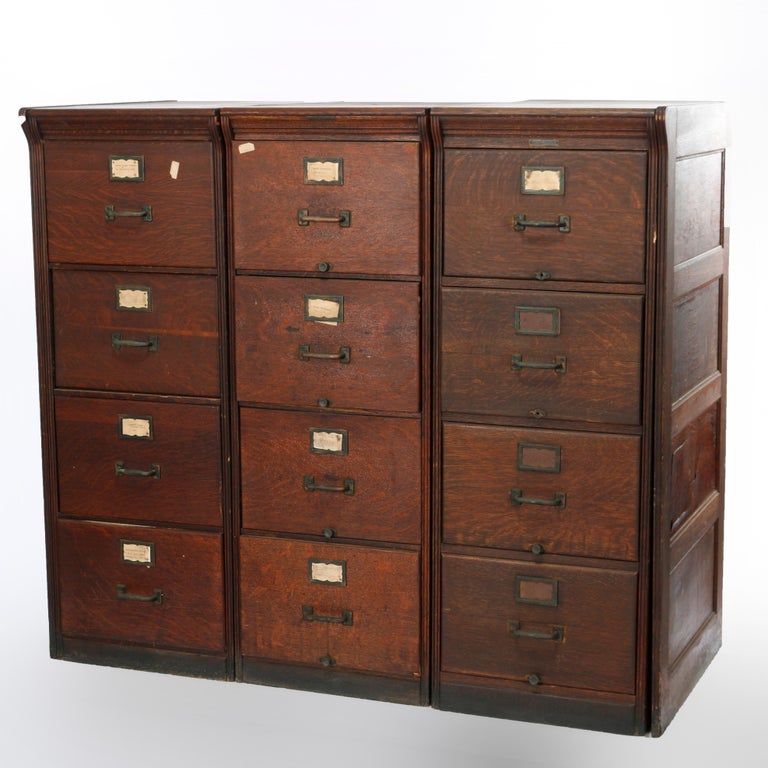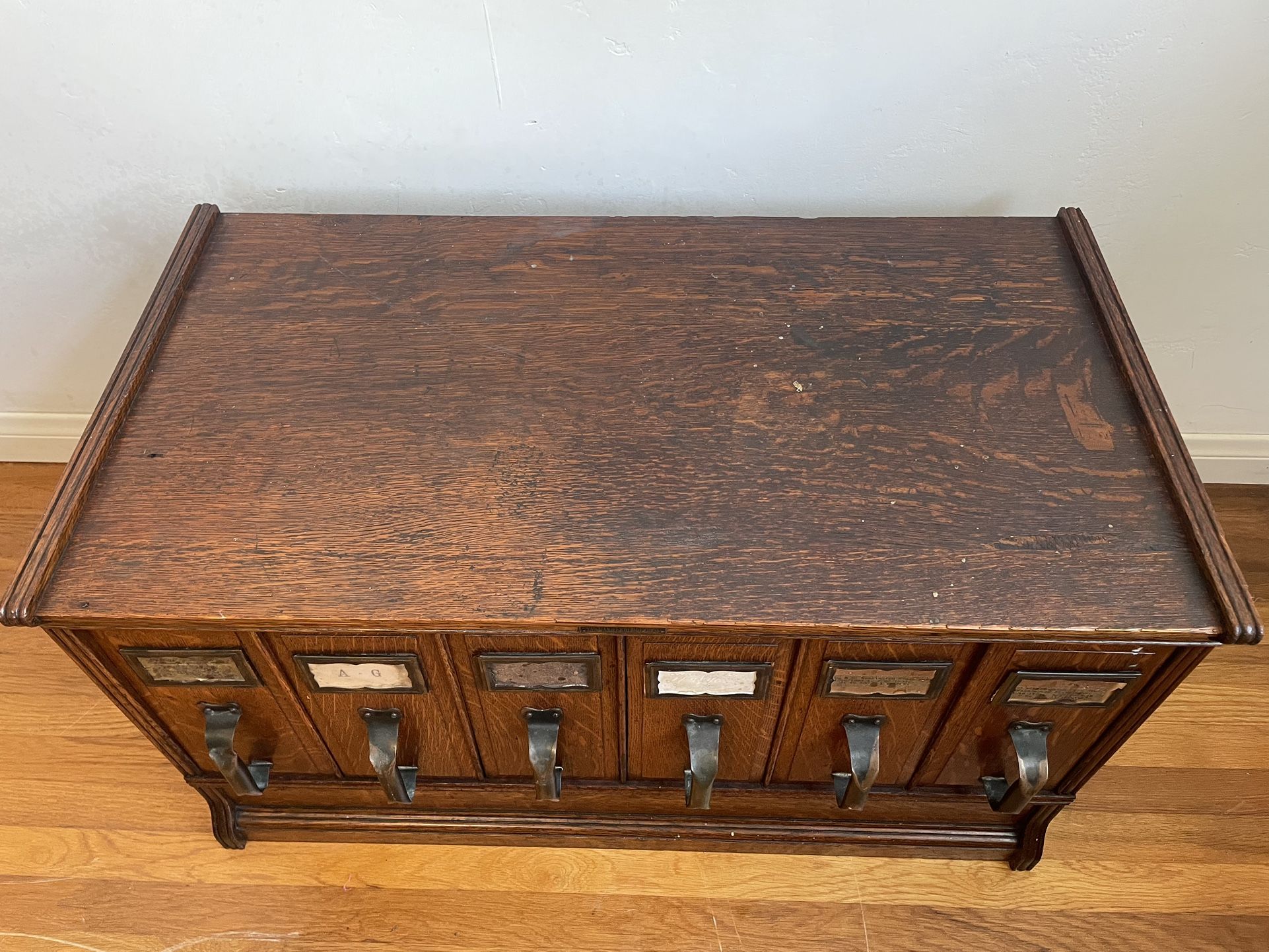History and Origin of Yawman and Erbe Antique File Cabinets

Yawman and Erbe, pioneers in the filing cabinet industry, left an indelible mark on office organization and record-keeping practices. Their journey began in the late 19th century, evolving from humble beginnings to become a leading force in the field.
Founding and Early Years
The story of Yawman and Erbe starts with the entrepreneurial spirit of two individuals: Ernest Yawman and Frederick Erbe. In 1890, they established their partnership in Rochester, New York, under the name Yawman & Erbe Manufacturing Company. Initially, they focused on manufacturing office furniture, but their true innovation came with the introduction of the vertical filing system.
The Vertical Filing System: A Revolution in Organization
Prior to Yawman and Erbe’s innovation, documents were typically stored in flat files, making retrieval cumbersome and inefficient. Recognizing this need, they developed the vertical filing system, which allowed for easier access and more efficient storage. This system revolutionized office organization, making it easier to manage and retrieve documents.
Designs and Innovations, Yawman and erbe antique file cabinet
Yawman and Erbe’s file cabinets were known for their durability, functionality, and aesthetic appeal. They introduced several innovations that shaped the industry, including:
- The “Yawman” File: This innovative design featured a unique hanging folder system that allowed for easier document retrieval and organization. The folders hung from rods within the file drawers, eliminating the need for bulky folders and providing better accessibility.
- The “Erbe” Cabinet: Erbe’s design focused on the cabinet itself, introducing features like adjustable shelves, fire-resistant materials, and improved locking mechanisms. This enhanced the functionality and security of the filing system.
- The “Vertical Filing System”: This system was the cornerstone of their success. It provided a more efficient and organized way to store and retrieve documents, leading to increased productivity in offices.
Impact on Office Organization and Record-Keeping
Yawman and Erbe’s innovations had a profound impact on office organization and record-keeping practices. The vertical filing system revolutionized the way offices managed documents, leading to:
- Increased Efficiency: The system allowed for faster and easier retrieval of documents, streamlining workflows and improving productivity.
- Improved Organization: The vertical filing system provided a more structured and organized way to store documents, making it easier to maintain order and find information.
- Enhanced Security: Yawman and Erbe’s file cabinets often incorporated features like fire-resistant materials and improved locking mechanisms, ensuring the security and preservation of important documents.
Design and Functionality of Yawman and Erbe Antique File Cabinets

Yawman and Erbe antique file cabinets, renowned for their durability and craftsmanship, were designed to provide efficient and secure storage for important documents. These cabinets, often made from sturdy materials like steel and wood, were meticulously crafted to withstand the test of time. Their unique designs and features offer a glimpse into the evolution of office organization and the importance of safeguarding valuable information.
Types of Yawman and Erbe File Cabinets
The variety of Yawman and Erbe file cabinets reflects their adaptability to different organizational needs.
- Lateral File Cabinets: These cabinets typically feature wide, horizontal drawers that slide smoothly on metal runners. They are ideal for storing large quantities of documents, such as legal files, blueprints, or financial records.
- Vertical File Cabinets: Designed for smaller spaces, vertical file cabinets have narrower drawers stacked vertically. They are perfect for storing standard-sized documents, such as letters, invoices, and reports.
- Card File Cabinets: These cabinets are designed for storing index cards or other small items. They often have smaller drawers with dividers to keep cards organized.
- Specialty File Cabinets: Yawman and Erbe also produced specialized file cabinets for specific purposes, such as map cabinets, blueprint cabinets, and even cabinets for storing valuable artifacts. These cabinets often featured unique features to accommodate the specific items being stored.
Construction Materials and Dimensions
The construction materials used in Yawman and Erbe file cabinets varied depending on the model and the intended use.
- Steel: Steel was a popular choice for Yawman and Erbe file cabinets due to its strength, durability, and resistance to fire. Steel cabinets were often finished with enamel paint for added protection and aesthetic appeal.
- Wood: Wood was also used in the construction of Yawman and Erbe file cabinets, particularly for more ornate models. Mahogany, oak, and walnut were common choices, adding a touch of elegance to office spaces.
- Dimensions: The dimensions of Yawman and Erbe file cabinets varied widely depending on the model and the intended purpose. Lateral file cabinets were generally larger than vertical file cabinets, while card file cabinets were smaller and more compact.
Features of Yawman and Erbe File Cabinets
Yawman and Erbe file cabinets were known for their innovative features, which enhanced their functionality and security.
- Drawer Mechanisms: Yawman and Erbe file cabinets often featured high-quality drawer mechanisms that ensured smooth and quiet operation. These mechanisms were designed to withstand years of use, providing reliable access to stored documents.
- Locking Systems: Security was a paramount concern for Yawman and Erbe. Many of their file cabinets were equipped with robust locking systems, often using multiple locks for added protection.
- Decorative Elements: Yawman and Erbe file cabinets were not just functional but also aesthetically pleasing. They often featured decorative elements, such as brass hardware, engraved labels, and intricate carvings, adding a touch of elegance to office environments.
Functionality of Yawman and Erbe File Cabinets
Yawman and Erbe file cabinets were designed to provide efficient organization, easy accessibility, and long-lasting durability.
- Organization: The drawer system of Yawman and Erbe file cabinets allowed for efficient organization of documents. File folders could be easily labeled and stored in designated drawers, making it simple to locate specific documents.
- Accessibility: The smooth-operating drawers of Yawman and Erbe file cabinets provided easy access to stored documents. This ensured that users could quickly and effortlessly retrieve the information they needed.
- Durability: Yawman and Erbe file cabinets were known for their durability. They were built with high-quality materials and craftsmanship, designed to withstand years of use and protect valuable documents from damage.
Collecting and Appreciating Yawman and Erbe Antique File Cabinets

Antique Yawman and Erbe file cabinets are more than just functional storage; they’re historical artifacts that can add a touch of vintage charm to any space. Their unique designs, craftsmanship, and historical significance make them highly sought after by collectors and enthusiasts alike.
Factors Contributing to Value and Desirability
Several factors influence the value and desirability of Yawman and Erbe antique file cabinets. These include:
- Condition: Like any antique, the condition of a Yawman and Erbe file cabinet is paramount. Cabinets in excellent condition, with minimal wear and tear, command higher prices. Conversely, cabinets with significant damage or restorations may be worth less.
- Rarity: Certain models or variations of Yawman and Erbe file cabinets are rarer than others. These rare pieces, especially those with unique features or historical significance, are often highly sought after by collectors and can command premium prices.
- Historical Significance: Cabinets associated with notable individuals, organizations, or events often carry added value. For example, a file cabinet used by a prominent historical figure or in a significant historical event would likely be considered a valuable collectible.
- Design and Craftsmanship: Yawman and Erbe file cabinets are known for their distinctive designs and high-quality craftsmanship. Cabinets with intricate details, unique materials, or innovative features are often more desirable to collectors.
- Originality: Authentic Yawman and Erbe file cabinets are highly prized. Collectors are particularly interested in pieces that retain their original hardware, finishes, and labels. Altered or restored cabinets may be less valuable.
Current Market Trends and Pricing
The market for Yawman and Erbe antique file cabinets is dynamic and influenced by various factors, including:
- Condition: As mentioned earlier, condition plays a significant role in pricing. A well-preserved cabinet in excellent condition can fetch several hundred to thousands of dollars.
- Rarity: Rare models or variations, especially those with unique features or historical significance, can command prices ranging from a few hundred to several thousand dollars, depending on their condition and desirability.
- Demand: The demand for specific models or styles can fluctuate based on current trends and collector preferences.
- Location: The geographic location of the sale can influence pricing. Auction houses or antique dealers in major cities may command higher prices than those in smaller towns.
Identifying Authentic Yawman and Erbe File Cabinets
Distinguishing authentic Yawman and Erbe file cabinets from imitations or reproductions requires careful examination:
- Hardware: Authentic Yawman and Erbe file cabinets often feature distinctive hardware, including handles, latches, and drawer pulls. Examine the hardware for markings, materials, and design details that are consistent with known Yawman and Erbe styles.
- Labels and Markings: Look for original labels or markings that identify the manufacturer and model. These labels are often found on the inside of drawers or on the cabinet’s exterior. Authentic labels typically have a specific font style, color, and placement.
- Construction: Authentic Yawman and Erbe file cabinets are known for their robust construction. Examine the cabinet’s joints, materials, and overall craftsmanship for signs of quality and consistency.
- Research and Comparison: Consult reliable sources, such as books, online databases, and collector forums, to compare the features of your cabinet with known Yawman and Erbe designs. Cross-referencing information from multiple sources can help confirm authenticity.
Yawman and Erbe antique file cabinets, with their intricate designs and sturdy construction, often evoke a sense of history and craftsmanship. While these cabinets are perfect for storing important documents, they can also serve as a beautiful display piece. For showcasing cherished items, consider a glass door display cabinet uk to enhance their visibility and add a touch of elegance.
Similar to Yawman and Erbe’s timeless appeal, these cabinets offer a modern solution for showcasing prized possessions while maintaining a sense of refined style.
While a Yawman and Erbe antique file cabinet might evoke images of a bygone era of meticulous record keeping, the principles of organization it embodies remain relevant today. Just as the file cabinet provided a structured system for storing documents, the Container Store shoe cabinet offers a modern solution for maintaining order in your footwear collection.
Both, in their own way, highlight the importance of creating designated spaces for specific items, ensuring that everything has its place and is easily accessible.
